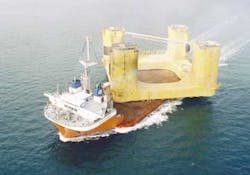Offshore Europe
Jeremy Beckman • London
Hydro pushing to double Oseberg output
Norsk Hydro is looking to extend production from its Oseberg area complex in the North Sea beyond 2030 and to double remaining recoverable reserves to 3.12 Bboe. Business Unit Head Oystein Michelsen outlined the company's thinking during a briefing at ONS Stavanger.
Oseberg came onstream in 1983. Today it provides half of Hydro's production and 10% of Norway's annual sales. The reserves have been developed in stages through four bridge-linked platforms, with gas exports starting in 2000 (some of the gas is re-injected). The complex also handles gas/condensate from the Tune field. Gas is sent to the Statpipe trunkline system via Hydro's Heimdal platform, while oil is piped to the Sture terminal in western Norway.
Recent events have allowed the company to posit new, longer-term scenarios. These include an extension of its concessions in this area to 2031 and the allocation of remaining unexplored acreage in touching distance to Hydro and its partners in Oseberg. But there are more urgent issues to resolve.
"The Oseberg platforms are heavy, old installations," Michelsen pointed out, "and our unit costs are increasingUalso, high tariff costs are hindering tie-ins of smaller fields in this area."
In the near future, there are plans to add three subsea satellites to the complex. The J-Struktur was due to be tied back to the Oseberg South platform this fall, but work has fallen behind schedule, due to Norway's continuing rig strike. Early next year, drilling is due to start on the Vestflanken accumulation, and a new subsea well (Tune 2) will be drilled through the Tune template. Thereafter, the next likeliest candidates are Tune 3, Delta, and G-Central, with a plan for the latter set to be issued in 2005.
"We see Oseberg going from a platform-based development to a host of subsea installations," Michelsen added, "with maybe 30 subsea wells five years from now."
But these measures alone won't double remaining reserves. That will involve more tie-ins of third-party fields, such as Hydro's Brage, and more concerted exploration drilling.
"We plan to drill three to five targets per year," he said, "more than half being side-tracks from production wells into unknown structures."
Hydro also plans to drill two test wells from the main field center into a Shetland chalk reservoir to the southeast. A strong result could mean development through a new platform with 18 wells. Another gas platform may also be needed to increase gas-processing capacity for the area generally, bridge-linked to the Oseberg D installation.
Waddenzee drilling could resume
Restrictions on offshore activity in the Waddenzee could soon be lifted, following a review by the Dutch government. Drilling and production in the region, off the northeast Netherlands coast, was halted in 1999 by environmental concerns. If activity resumed, this could free up 1.2 tcf for immediate development, according to UK analysts Wood Mackenzie.
Between 1995-99, NAM was allowed to drill several deviated wells under the sea from two onshore locations at Lauwersoog and Modelergat. These led to the discovery of at least five commercial fields. Develop-ment started soon afterward, but as work on the onshore sites neared completion in 1999, the government intervened, pulling the plug on all activity. The main issue was the potential impact of subsidence caused by gas production on the local ecosystem. Several studies have since been mounted using measurements from fields nearby already in production. All concluded that subsidence would be offset by the continuous inflow of sediments from tidal movements into the Waddenzee.
Assuming the ban is lifted, the suspended offshore fields could be brought onstream by 2007-08, Wood Mackenzie says. This would entail installation of two pipelines to the nearby gas treatment plant at Anjum, where capacity is 350 MMcf/d, plus modifications at two of the onshore drilling locations. All five discovery wells would be completed as producers, and should only require minor workovers. More development wells would likely follow, with compression probably added after five years of production. The analysts also believe 1.1 to 4.6 tcf is waiting to be discovered in the eastern part of the Waddenzee, if seismic analysis is to be trusted.
French acreage shrinks
Licensed acreage offshore France dropped by 25% last year to just over 37,000 sq km. According to the Bureau Exploration-Production des Hydrocarbures, only three offshore permits remain in force, following the expiry of blocks held by CNR in the Iroise Sea basin, in the Channel, and by Esso in the Bay of Biscay. However, Hunt has filed an application for a new permit extending over 8,000 sq km in the Biscay region, and another company has requested a reconnaissance permit for an area offshore Corsica.
Kristin jigsaw taking shape
First shipments of Statoil's Kristin semisubmersible platform have been arriving at the Aker Stord integration yard in western Norway. Dockwise's Mighty Servant I barge transported the 14,620-ton hull from Samsung's yard in Koje, Korea, while another Dockwise ship, the Tern, brought the riser balcony and flare tower a shorter distance from the Dragados yard in Puerto Real, Spain. The living quarters and helideck, built by Emtunga in Sweden, were due to follow. Mating of the topsides to the substructure should have been completed by now, with tow-out to the field in the Norwegian Sea scheduled for March 25. First gas/condensate from Kristin is due next October. Statoil is already looking ahead to future satellite developments to the platform, including a potential 40-km tieback of the Tyrihans field.
null

